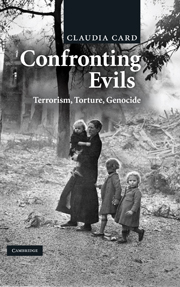Book contents
- Frontmatter
- Contents
- Preface and acknowledgements
- List of acronyms and abbreviations
- PART I The concept of evil
- 1 Inexcusable wrongs
- 2 Between good and evil
- 3 Complicity in structural evils
- 4 To whom (or to what) can evils be done?
- PART II Terrorism, torture, genocide
- Bibliography
- List of films referred to
- List of websites for international documents
- Index
4 - To whom (or to what) can evils be done?
Published online by Cambridge University Press: 05 June 2012
- Frontmatter
- Contents
- Preface and acknowledgements
- List of acronyms and abbreviations
- PART I The concept of evil
- 1 Inexcusable wrongs
- 2 Between good and evil
- 3 Complicity in structural evils
- 4 To whom (or to what) can evils be done?
- PART II Terrorism, torture, genocide
- Bibliography
- List of films referred to
- List of websites for international documents
- Index
Summary
The atrocity paradigm can make sense of ecological evils the victims of which include trees and even ecosystems. (Card 2002, p. 16)
Much of this chapter is devoted to clarifying what it means for non-sentient entities, including plants, species, and ecosystems, as well as human groups, to suffer harm (as distinct from being wronged) and what it means for that harm to be intolerable. More of this chapter is taken up with plant life, species, and ecosystems than with human groups. But chapters 9 and 10 revisit at greater length issues of harm to human groups. Environmental atrocities are not represented in Part ii of this book, although torture of laboratory animals is considered in chapter 8. Yet, in responding to atrocities, it is important to avoid not only evils to other people but environmental atrocities as well. It is part of the agenda of this chapter to give sense to environmental atrocities as not entirely human-centered or even pain-centered. Thinking about harm to human groups, insofar as they are not sentient entities, benefits from thinking about harm to non-sentient entities in the natural environment. And so, most of the focus in this chapter on harm to human groups is reserved to the penultimate section.
CONTEXTS AND PROBLEMATIC CASES
In The Atrocity Paradigm, I baldly asserted that evils are done to trees and ecosystems and then deferred indefinitely the task of explaining how or what that would mean.
- Type
- Chapter
- Information
- Confronting EvilsTerrorism, Torture, Genocide, pp. 88 - 120Publisher: Cambridge University PressPrint publication year: 2010



